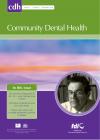Community Dental Health

- Cover Date:
- September 2010
- Print ISSN:
- 0265 539X
- Vol:
- 27
- Issue:
- 3
Short Communication - Wheelchair-accessible dental offices in Nagasaki, Japan
Objective: To determine the proportion of dental offices in Nagasaki, Japan, that are wheelchair accessible and to identify factors related to the adoption of barrier-free designs within the study area. Methods: All 703 dental offices managed by members of the Nagasaki Prefecture Dental Association were studied. We evaluated the accessibility of the offices to wheelchair users and compared the percentage and adjusted odds ratio of the accessible dental offices according to dental office characteristics. Results: Of the respondents, 62% deemed their offices accessible. The percentage and adjusted odds ratio of accessible offices were significantly higher for offices offering more specialties, providing more frequent home visits, and with younger head dentists. Conclusion: According to the self-reported results from dentists, more than one third of the dental offices in Nagasaki were not easily accessible by mobility-impaired persons. Dentists should the understand architectural and perceptual barriers faced by handicapped persons and the aged and consider barrier-free office designs for all patients. Keywords: Dental office design, physically disabled persons, wheelchair
Introduction
In Japan, “The Law for Promoting Easily Accessible Public Transportation Infrastructure for the Aged and Disabled†was enacted in December 2006. The goal of this law was to promote a barrier-free environment and ensure safe access to public transport facilities and buildings (Government, 2006). Taking leadership in this area, in 1998, Nagasaki prefecture in Japan enacted an ordinance to improve accessibility for aged and disabled persons to any facility related to daily life including dental offices. The ordinance forces an owner who is planning to construct a new dental office to submit an architectural checklist to Nagasaki prefecture. Nagasaki prefecture examines this checklist and gives advice regarding design changes, if there are unsuitable items on the checklist. After passing the examination by Nagasaki prefecture, Nagasaki prefecture certifies the dental office and adds the information on this office to the Nagasaki prefecture web site, if the dentist agrees to this. Although dental offices that were constructed before the ordinance was passed are exempt from this regulation, Nagasaki prefecture recommends that they improve accessibility for aged and disabled persons. Barriers to accessing dental services, such as fear and anxiety over dental treatment, low income, and communication problems, especially for aged and disabled persons, have been well documented (Gordon et al., 1998, Kane et al., 2008, De Jongh et al., 2008). Although various kinds of barriers exist in this regard, architectural barriers remain the biggest, as they can block access to dental care services. In 2006, a Japanese national survey sent to handicapped persons regarding their daily lives revealed that architectural barriers were the most frequent problem encountered when physically
handicapped persons went out (Ministry of Health, 2006). The Nagasaki Prefecture Dental Association (NPDA) conducted a survey that included items on dental office design for wheelchair users to all its members. We used the survey results to determine the proportion of dental offices that have adopted a barrier-free design for wheelchair users and to identify factors that were related to the adoption of barrier-free designs in the study area.
Methods
Approximately 95% of the private dentists in Nagasaki prefecture are members of the NPDA, which consists of 791 dentists with their own dental offices. The NPDA sent a questionnaire to all 703 dental offices managed by a member of the NPDA in July 2006. The NPDA has continued to study the activities of these dental offices, from 2004 to 2008, to identify trends in dental office activities as well as patients’ needs. We added one questionnaire item about the accessibility to wheelchair users to this study in 2006. In addition, the NPDA asked all respondents to report the details of treatment for all patients who visited their dental office on 12 July 2006. The mean age of all patients for each dental office was calculated based on these reports of the treatment needs of their patients. All of the dental offices were asked to complete all of the items in the questionnaire and to return the questionnaire to the head office of the NPDA anonymously. In all, 591 dental clinics returned valid questionnaires for a response rate of 84.1%. The respondents were asked to evaluate the accessibility of their dental office to wheelchair users by the following questionnaire item: “Can wheelchair users move from outside your dental office to a dental chair by themselves?†The respondents selected one of three
Correspondence to: Dr. Hideki Fukuda, Department of Oral Health, Nagasaki University Graduate School of Biomedical Sciences, 1-7-1 Sakamoto, Nagasaki 852-8588 JAPAN. E-mail: fhideki@nagasaki-u.ac.jp
- Article Price
- £15.00
- Institution Article Price
- £
- Page Start
- 187
- Page End
- 190
- Authors
- H. Fukuda, M.Tsunomachi, T. Doutsu
Articles from this issue
- Title
- Pg. Start
- Pg. End
- Plaque, caries level and oral hygiene habits in young patients receiving orthodontic treatment
- 133
- 138
- Oral health and treatment needs of institutionalized chronic psychiatric patients in Istanbul, Turkey.
- 151
- 157
- Social differences in tooth decay occurrence in a sample of children aged 3 to 5 in North-East Italy
- 163
- 166
- Child oral health concerns amongst parents and primary care givers in a Sure Start Local Programme
- 167
- 171
- A 6-year longitudinal study of caries in teenagers and the effect of “dropouts†on the findings
- 172
- 177
